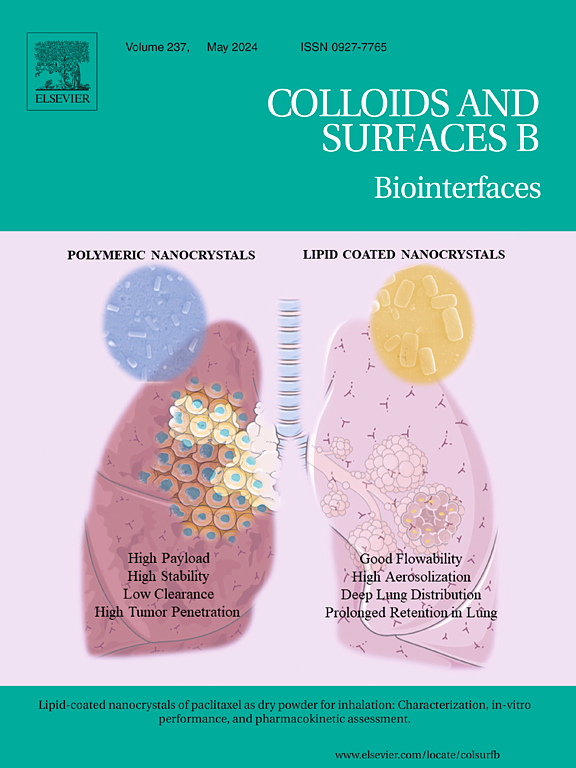可调节纳米颗粒共同靶向巨噬细胞和内皮细胞,增强动脉粥样硬化治疗
IF 5.4
2区 医学
Q1 BIOPHYSICS
引用次数: 0
摘要
在动脉粥样硬化(AS)的病理过程中,巨噬细胞和功能失调的内皮细胞通过炎症放大、氧化应激和信号通路的相互作用,形成一条炎症-损伤轴。两种细胞协同靶向干预是改善斑块微环境,实现疾病逆转的关键。然而,血管内膜下的脂质核阻碍了大尺寸纳米颗粒渗透到斑块中功能失调的巨噬细胞中,难以阻断巨噬细胞与内皮细胞之间的恶性循环。为此,我们设计了一个可调节大小的纳米颗粒(CS/PArg@Cur-HSA),该纳米颗粒由一个小尺寸的姜黄素(Cur)-人血清白蛋白(Cur-HSA) (Cur-HSA)复合物组成为核心,其表面包被细胞穿透肽聚精氨酸(PArg),并进一步包被硫酸软骨素(CS)作为靶向配体。体外实验表明,CS/PArg@Cur-HSA显著增强了对巨噬细胞的靶向能力,抑制了巨噬细胞向促炎表型的极化,减少了氧化低密度脂蛋白(ox-LDL)诱导的泡沫细胞的形成。同时增强内皮细胞的抗炎能力,改善内皮功能。体内评估显示,该制剂可显著减少斑块积累,改善斑块内脂质沉积和炎症细胞浸润,并通过协同调节延缓疾病进展。本研究为可调节纳米给药系统在AS治疗中的应用提供了一种新的策略。本文章由计算机程序翻译,如有差异,请以英文原文为准。
Size-adjustable nanoparticles co-target macrophages and endothelial cells for enhanced atherosclerosis therapy
In the pathological process of atherosclerosis (AS), macrophages and dysfunctional endothelial cells form an inflammation-injury axis through inflammatory amplification, oxidative stress, and interaction of signaling pathways. The synergistic targeted intervention of the two cells is the key to improve the plaque microenvironment and achieve disease reversal. However, the lipid core under the vascular intima hinders the penetration of large-sized nanoparticles into dysfunctional macrophages in the plaque, making it hard to block the vicious circle between macrophages and endothelial cells. To this end, we engineered a size-adjustable nanoparticle (CS/PArg@Cur-HSA), which was consisted of a small-sized curcumin (Cur)-human serum albumin (HSA) (Cur-HSA) complex as the core, and its surface was coated with cell-penetrating peptide poly(arginine) (PArg), further encapsulating it with chondroitin sulfate (CS) as a targeting ligand. In vitro experiments demonstrated that CS/PArg@Cur-HSA significantly enhanced targeting ability to macrophages, inhibited the polarization of macrophages to the pro-inflammatory phenotype, and reduced the formation of foam cells induced by oxidized low-density lipoprotein (ox-LDL). While it also enhanced the anti-inflammatory capacity of endothelial cells and improved endothelial function. In vivo evaluation revealed that the preparation significantly reduced the plaque accumulation, ameliorated intraplaque lipid deposition and inflammatory cell infiltration, and retarded disease progression through synergistic modulation. This study provided a new strategy for the application of size-adjustable nano-drug delivery systems in AS therapy.
求助全文
通过发布文献求助,成功后即可免费获取论文全文。
去求助
来源期刊

Colloids and Surfaces B: Biointerfaces
生物-材料科学:生物材料
CiteScore
11.10
自引率
3.40%
发文量
730
审稿时长
42 days
期刊介绍:
Colloids and Surfaces B: Biointerfaces is an international journal devoted to fundamental and applied research on colloid and interfacial phenomena in relation to systems of biological origin, having particular relevance to the medical, pharmaceutical, biotechnological, food and cosmetic fields.
Submissions that: (1) deal solely with biological phenomena and do not describe the physico-chemical or colloid-chemical background and/or mechanism of the phenomena, and (2) deal solely with colloid/interfacial phenomena and do not have appropriate biological content or relevance, are outside the scope of the journal and will not be considered for publication.
The journal publishes regular research papers, reviews, short communications and invited perspective articles, called BioInterface Perspectives. The BioInterface Perspective provide researchers the opportunity to review their own work, as well as provide insight into the work of others that inspired and influenced the author. Regular articles should have a maximum total length of 6,000 words. In addition, a (combined) maximum of 8 normal-sized figures and/or tables is allowed (so for instance 3 tables and 5 figures). For multiple-panel figures each set of two panels equates to one figure. Short communications should not exceed half of the above. It is required to give on the article cover page a short statistical summary of the article listing the total number of words and tables/figures.
 求助内容:
求助内容: 应助结果提醒方式:
应助结果提醒方式:


